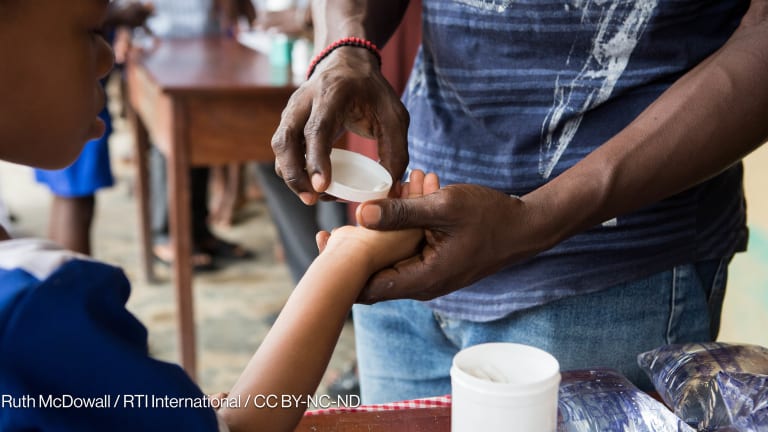
One hundred and twenty-five years ago, British doctor Ronald Ross discovered that female mosquitoes transmit malaria to humans. Yet, today, millions of lives are still lost every year to the malaria parasite and the mosquitoes that spread it.
Since 2000, global partnership has saved over 10.6 million lives from malaria. However, progress has recently stalled in the highest malaria-burdened countries, with 627,000 malaria deaths recorded in 2020 — 69,000 more than the year before and mostly among African children under 5 years of age.
While drug resistance, limited funding for the global malaria response, and COVID-19 pandemic disruptions are partly to blame for setbacks in the malaria response, mosquitoes present an urgent threat, outsmarting current technologies developed to eliminate them. There is no single solution to malaria eradication, yet pushing forward with the existing array of innovative tools and initiatives and increasing global funding for research and development is key in the fight against mosquitoes, and to end malaria.
Global Fund replenishment: Pledges, expectations, and what's at stake
So far, the Global Fund has received pledges amounting to just almost half of its funding goal, roughly $8.8 billion.
This month, global leaders have a unique opportunity to build on current malaria prevention and eradication work by stepping up their pledges at the Global Fund to Fight AIDS, Tuberculosis and Malaria’s seventh replenishment, hosted by U.S. President Joe Biden on Sept. 21 in New York. Here are some of the reasons why the time is now to bite back against mosquitoes.
Urgent threats to malaria elimination
In Africa, malaria prevention largely relies on the use of insecticides. But widespread use of pyrethroids through massive deployment of bed nets and indoor insecticide spraying has led to mosquitoes evolving to survive after contact with insecticides — in some cases reducing their effectiveness, or even learning to avoid them altogether.
Mosquitoes are also changing their biting behaviors, becoming more active during the day. When coupled with the human tendency to stay out later, two crucial methods for preventing malaria when we’re home at night — bed nets and indoor insecticide spraying — are rendered less effective.
In Africa, malaria parasites have also developed resistance to artemisinin-based drugs, the current most efficacious and first-line medicines used to treat malaria patients. A recent study found that the drug resistance mutations, similar to those seen in Asia, have reduced the speed at which these treatments take effect.
I cannot accept that a child still dies every minute from a mosquito bite, so I call on global leaders … to fight for what counts; let’s end malaria once and for all.
—Regions currently free from malaria are also at risk, with rising temperatures and more frequent natural disasters due to climate change creating favorable conditions for malarial mosquitoes to thrive. And while rural areas are most commonly affected by the disease, urban areas of the Horn of Africa have now seen invasive mosquito species usually found in India.
Constant innovation needed to stay a step ahead
The parasite and the mosquitoes that transmit it are constantly evolving, adapting to new threats and resisting even our most effective tools. The trick to fighting malaria is investing in constant innovation to efficiently target the deployment of existing tools and accelerate the development of new and varied interventions.
The good news is that crucial work is being done to optimize current tools. With support from the Global Fund, Bill & Melinda Gates Foundation, Project Management Institute and others, initiatives such as the Innovative Vector Control Consortium are developing new nets that use a combination of insecticides instead of just one. Early research indicates they can reduce the prevalence of malaria by over a third compared to standard nets.
Tanzania’s Ifakara Health Institute is helping develop Attractive Targeted Sugar Bait , or ATSB, devices that attract and kill malaria-carrying mosquitoes. Not-for-profit research consortium Target Malaria is working in several African countries to build gene modification and gene drive strategies that could reduce malaria-vector mosquito populations by affecting their reproductive ability. And new vaccine candidates are following in the footsteps of the first malaria vaccine approved by the World Health Organization, while the pharmaceutical industry is exploring new treatments to tackle parasite resistance to antimalarial drugs.
Investments in transformative innovations will also be critical for the last mile of the malaria fight. Our pipeline includes the use of monoclonal antibodies and a significant project from BioNTech and the kENUP Foundation to develop the first mRNA-based prophylactic malaria vaccine.
Advanced surveillance techniques — including genetic sequencing — are also critical to tracking resistance in close to real time. In Mozambique, Malaria Consortium is collaborating with the Ministry of Health to study the parasite’s genetic diversity, detect antimalarial drug resistance, and understand how gene deletions could impact the effectiveness of diagnostic tests. Such research will help establish more sophisticated surveillance systems in health facilities, enhance data, and guide decision-making.
Despite progress to outwit the constantly evolving foe, there is no silver bullet to end malaria. A diverse toolbox of these innovative tools and approaches will be required to end malaria for good, with existing and effective tools used strategically.
A successful Global Fund replenishment is crucial
COVID-19 has underlined the critical importance of R&D and ensuring access to innovative tools among the most vulnerable populations to overcome global health threats. Crucially, the pandemic has also demonstrated what can be achieved with the right commitments.
As world leaders come together next week at the Global Fund’s seventh replenishment to achieve the target of at least $18 billion to harness innovation to save 20 million more lives from malaria, HIV/AIDS, and tuberculosis, it is vital to remind ourselves that the fight against malaria is at a precarious juncture.
The mosquito is small but deadly; we cannot be complacent. As a scientist and mother, I cannot accept that a child still dies every minute from a mosquito bite, so I call on global leaders, scientists, and communities to fight for what counts; let’s end malaria once and for all.









